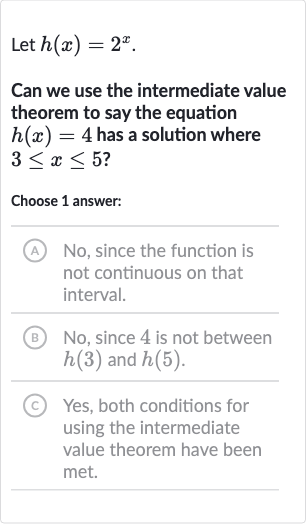AI tutor
Welcome to Bytelearn!
Let’s check out your problem:

Let .Can we use the intermediate value theorem to say the equation has a solution where ?Choose answer:(A) No, since the function is not continuous on that interval.(B) No, since is not between and .(C) Yes, both conditions for using the intermediate value theorem have been met.
Full solution
Q. Let .Can we use the intermediate value theorem to say the equation has a solution where ?Choose answer:(A) No, since the function is not continuous on that interval.(B) No, since is not between and .(C) Yes, both conditions for using the intermediate value theorem have been met.
- Recall IVT: First, let's recall the Intermediate Value Theorem (IVT). The IVT states that if a function is continuous on a closed interval and is any number between and , then there is at least one number in the interval such that . We need to check if the function is continuous on the interval and if the value lies between and .
- Evaluate Endpoints: Now, let's evaluate the function at the endpoints of the interval. First, we calculate .
- Check Value : Next, we calculate .
- Continuity of : We have and . Now we need to check if the value is between and . Since is less than and is less than , it is clear that is indeed between and .
- Apply IVT: The function is an exponential function, which is known to be continuous everywhere on its domain, which includes all real numbers. Therefore, is continuous on the interval .
- Apply IVT: The function is an exponential function, which is known to be continuous everywhere on its domain, which includes all real numbers. Therefore, is continuous on the interval .Since is continuous on and is between and , both conditions for using the Intermediate Value Theorem have been met. Therefore, we can conclude that there is at least one solution to the equation on the interval .
More problems from Write a quadratic function from its x-intercepts and another point
QuestionGet tutor help
